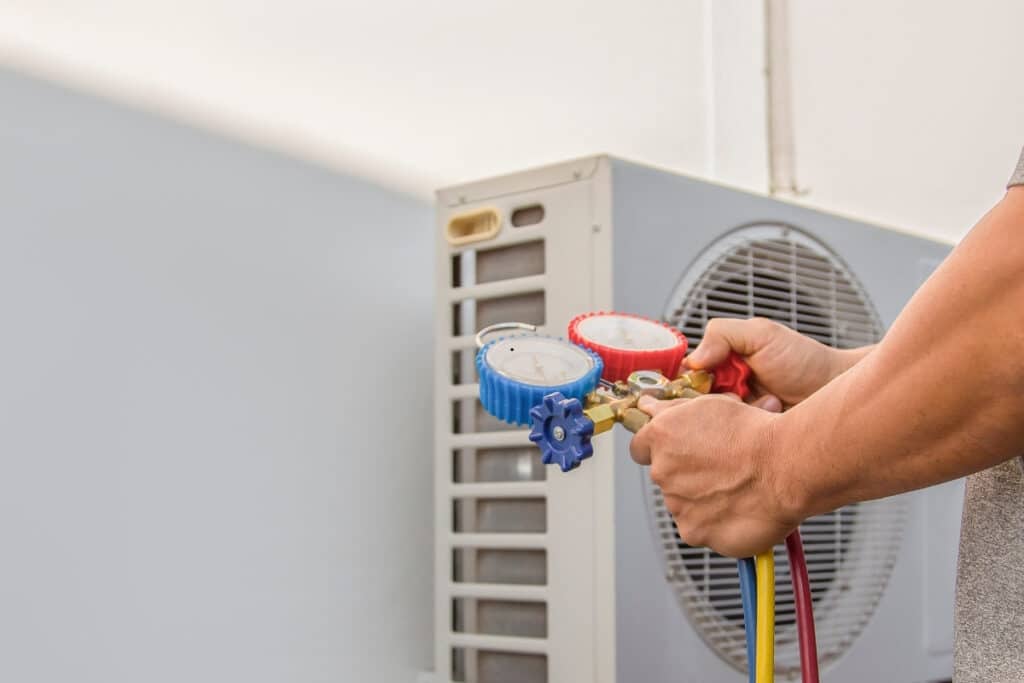The relentless Texas heat is no joke. When the summer sun beats down on Fort Worth, a functioning air conditioning system isn’t just a luxury – it’s an absolute necessity for comfort, safety, and sanity. So, when your AC unit starts sputtering, blowing warm air, or worse, completely conking out, a wave of panic is entirely understandable. Knowing what to do, what to look for, and when to call in the professionals for AC repair can save you from sweltering days and unexpected expenses.
This comprehensive guide is designed for Fort Worth homeowners to help navigate the often-stressful world of AC breakdowns. We’ll cover common culprits, offer troubleshooting tips you can try yourself, and, most importantly, equip you with the knowledge to choose a reputable repair service when the job calls for expert hands.
Is Your AC Whispering for Help, or Screaming for Repair?
Your air conditioner rarely just dies without warning. Often, it gives off subtle (or not-so-subtle) cues that something is amiss. Paying attention to these signs can allow you to address issues early, potentially preventing more costly repairs down the line.
- Warm Air Blowing: This is the most obvious red flag. If your vents are pushing out air that feels more like a gentle breeze on a warm day than a refreshing chill, your AC is clearly struggling. This could be due to low refrigerant, a failing compressor, a clogged air filter, or issues with your outdoor unit.
- Weak Airflow: Even if the air is cool, if it’s barely trickling out of the vents, your system isn’t moving enough air to cool your home effectively. This often points to clogged air filters, blocked return vents, issues with your blower motor, or even ductwork leaks.
- Strange Noises: AC units are not silent, but they shouldn’t sound like a monster movie.
- Grinding or Squealing: Often indicates a problem with motor bearings (blower motor or outdoor fan motor) or a worn-out belt.
- Clicking: A single click when the unit turns on or off is normal. Rapid or persistent clicking could indicate an electrical issue or a failing relay.
- Banging or Clanking: Suggests a loose part within the blower assembly or outdoor unit.
- Hissing: Could mean a refrigerant leak, especially if accompanied by reduced cooling.
- Gurgling: Sometimes heard when refrigerant is circulating, but excessive gurgling could indicate air in the lines or a blockage.
- Unpleasant Odors: Your AC should ideally be odorless.
- Musty/Moldy Smell: Indicates mold or mildew growth in the evaporator coil or ductwork, often due to excess moisture.
- Burning Smell: Immediately turn off your AC and call a technician. This suggests an electrical problem, burnt wiring, or an overheating motor.
- Foul/Sewer Gas Smell: Can indicate a dry P-trap in your drain line, allowing sewer gases to enter your home.
- Frequent Cycling (Short-Cycling): If your AC turns on, runs for a short period (e.g., less than 10-15 minutes), and then shuts off, only to repeat the process frequently, it’s “short-cycling.” This wears out components faster, wastes energy, and often fails to adequately cool your home. Causes include an oversized unit, low refrigerant, a clogged filter, or electrical issues.
- High Humidity Indoors: Beyond just cooling, AC systems also remove humidity. If your home feels clammy even when the temperature is set low, your AC isn’t dehumidifying properly. This can be due to an oversized unit (which cools too quickly without enough runtime to remove humidity), low refrigerant, or issues with the evaporator coil.
- Water Leaks: Puddles around your indoor unit (furnace/air handler) are a definite problem. This usually means a clogged condensate drain line, allowing condensation to overflow. It can lead to water damage and mold growth.
- Increased Energy Bills: If your electricity bills suddenly spike without a significant change in usage habits, your AC might be working harder (and less efficiently) due to an underlying issue.
DIY Troubleshooting: What You Can Check Before Calling for Help
Before picking up the phone, a few simple checks can often resolve minor issues or, at least, help you explain the problem more clearly to a technician.
- Check the Thermostat:
- Is it set to “Cool” and below the current room temperature?
- Are the batteries fresh (if applicable)?
- Is it set to “Auto” fan mode, not “On” (unless you specifically want continuous fan operation)?
- Is the date and time correct? (Some smart thermostats rely on this for scheduling.)
- Inspect the Air Filter: A clogged air filter is the most common cause of poor airflow and reduced efficiency. Check it monthly and replace it every 1-3 months, or more frequently if you have pets or allergies. A dirty filter restricts airflow, making your system work harder and potentially freeze up.
- Check the Circuit Breaker: Go to your main electrical panel. Locate the breaker labeled for your “AC,” “Furnace,” or “Air Handler.” If it’s tripped (usually halfway between ON and OFF), flip it completely to OFF, then firmly back to ON. If it trips again immediately or frequently, do not keep resetting it – this indicates a serious electrical problem requiring professional attention.
- Clear the Outdoor Unit (Condenser): Ensure the outdoor unit is clear of debris. Leaves, grass clippings, dirt, and even overgrown bushes can restrict airflow, causing the unit to overheat and operate inefficiently. Use a garden hose (on a gentle setting) to rinse off the coils. Ensure the power to the unit is OFF at the outdoor disconnect switch first.
- Check for Frozen Coils: If your indoor unit (air handler) is covered in ice, your evaporator coil is frozen. This is usually caused by severely restricted airflow (dirty filter, blocked vents) or low refrigerant.
- What to do: Turn off your AC unit at the thermostat, but leave the fan running (set to “ON” or “Fan Only”) to help melt the ice. This can take several hours. While it’s thawing, inspect your filter and clear any blocked vents. Once thawed, restart the AC. If it freezes again quickly, you have an underlying issue.
- Examine the Condensate Drain Line: If you have a water leak, locate the condensate drain pan (usually under the indoor unit) and the PVC drain pipe. If it’s clogged, you might see standing water or even a float switch that has tripped, shutting off the system. You can often clear minor clogs with a wet/dry vacuum at the end of the drain line (often outside).
When to Call the Fort Worth AC Repair Experts
While DIY troubleshooting can fix minor issues, many AC problems require the specialized tools, training, and experience of a certified HVAC technician. Do not attempt complex repairs involving refrigerant, electrical components, or internal unit diagnostics unless you are a qualified professional.
Call an AC repair professional immediately if you experience:
- No Cooling Whatsoever: Beyond simple thermostat or breaker issues.
- Burning Smells: Electrical hazards are serious.
- Refrigerant Leaks (Hissing sounds, ice on outdoor unit, diminished cooling): Refrigerant handling requires EPA certification.
- Loud, Persistent Grinding, Banging, or Squealing Noises: Indicates failing motors or components.
- Frequent Circuit Breaker Tripping: Signals an electrical short or overload.
- Persistent Short-Cycling: Wears out your system rapidly.
- Water Leaks that you cannot clear easily.
- Any issue you don’t feel comfortable diagnosing or fixing yourself.
Choosing the Right AC Repair Company in Fort Worth
Fort Worth has no shortage of HVAC companies, but choosing the right one is crucial for reliable service and fair pricing. Here’s what to look for:
- Licensing and Certification: In Texas, HVAC contractors must be licensed by the Texas Department of Licensing and Regulation (TDLR). Always ask for their license number and verify it online. Technicians should also be NATE (North American Technician Excellence) certified, indicating a high level of competency.
- Experience and Reputation: Look for companies with a long-standing presence in the Fort Worth area. Check online reviews (Google, Yelp, BBB, Nextdoor) and ask for local references. A strong reputation built over years is a good indicator of quality service.
- Transparent Pricing: A reputable company will provide a detailed, written estimate before starting any work. Be wary of companies that give vague quotes over the phone or push for immediate, high-pressure decisions. They should explain the problem clearly and present options.
- Comprehensive Diagnostics: A good technician won’t just guess. They’ll perform a thorough diagnostic of your entire system to pinpoint the root cause of the problem, not just treat the symptom.
- Warranty on Repairs: Ask about the warranty on parts and labor for the repair. A good company stands behind its work.
- 24/7 Emergency Service: Fort Worth summers demand immediate attention. Many reputable companies offer emergency services for those critical breakdowns.
- Customer Service: Pay attention to how they handle your initial call. Are they polite, knowledgeable, and responsive? Good customer service is a sign of a well-run business.

Preventing Future Breakdowns
The best repair is often the one you don’t need. Regular maintenance is key to extending the life of your AC unit, improving efficiency, and preventing unexpected breakdowns.
- Regular Filter Changes: As mentioned, this is the easiest and most impactful DIY maintenance task.
- Annual Professional Tune-Ups: Schedule a professional AC tune-up every spring before the heat hits. A technician will:
- Clean coils (evaporator and condenser).
- Check refrigerant levels and pressures.
- Inspect electrical connections and components.
- Lubricate moving parts.
- Check condensate drain line for clogs.
- Calibrate the thermostat.
- Test overall system operation.
- Keep Vents Clear: Ensure all supply and return vents inside your home are unobstructed by furniture, rugs, or drapes.
- Clear Around Outdoor Unit: Maintain at least 2 feet of clear space around your outdoor condenser unit for optimal airflow.
When your AC falters in the Fort Worth heat, it’s a race against discomfort. While some minor issues can be addressed with simple DIY checks, knowing when to call a professional is paramount.
Investing in a reputable, licensed, and experienced AC repair service ensures that your system is diagnosed accurately, repaired effectively, and that your home quickly returns to being a cool, comfortable sanctuary from the Texas sun. Don’t wait until you’re sweating; address those warning signs, maintain your system regularly, and be prepared to call in the cavalry when needed.






